Choosing the Right Fire Sprinkler System for Your Property: A Comprehensive Guide
Fire sprinkler systems are essential for protecting buildings and occupants from fire damage. Selecting the right system for your property involves understanding various types, features, and requirements. This comprehensive guide will help you make an informed decision by outlining key considerations and providing practical advice for choosing the best fire sprinkler system for your needs.
Understanding Fire Sprinkler Systems
Fire sprinkler system are designed to automatically detect and extinguish fires, reducing damage and enhancing safety. These systems are crucial for both residential and commercial properties, and their effectiveness depends on proper selection, installation, and maintenance.
Types of Fire Sprinkler Systems
Wet Pipe Systems
Wet pipe systems are the most common type of fire sprinkler system. They consist of pipes filled with water that are connected to sprinklers throughout the building. When a fire is detected, the heat activates the sprinklers, allowing water to flow and extinguish the fire. This system is reliable and simple, making it suitable for most properties.
Dry Pipe Systems
Dry pipe systems are used in environments where temperatures may drop below freezing. In these systems, the pipes are filled with pressurized air or nitrogen, and water is stored in a separate tank. When a fire is detected, the pressurized air is released, allowing water to flow through the pipes and activate the sprinklers. Dry pipe systems are ideal for areas prone to freezing, such as unheated warehouses or exterior spaces.
Pre-Action Systems
Pre-action systems are a combination of wet and dry pipe systems. They require two separate events to occur before water is released: a fire detection system must first sense smoke or heat, and then the sprinkler heads must activate. This system is often used in environments with valuable equipment or sensitive materials, as it minimizes the risk of accidental water damage.
Deluge Systems
Deluge systems are used in high-hazard areas where rapid fire suppression is needed. These systems have open sprinkler heads and use a large volume of water to control fires. When the fire detection system activates, water is released simultaneously through all the sprinklers. Deluge systems are commonly used in areas with flammable materials or high-risk operations.
Foam Systems
Foam systems are designed to suppress flammable liquid fires, such as those involving gasoline or chemicals. They use a mixture of foam concentrate and water to create a foam blanket that smothers the fire. Foam systems are often used in industrial facilities, airports, and storage areas for hazardous materials.
Key Considerations for Choosing a Fire Sprinkler System
Property Type and Usage
The type of fire sprinkler system you choose should be based on the type of property and its usage. For residential properties, a wet pipe system is typically sufficient. For commercial properties or those with specific hazards, you may need a more specialized system, such as a dry pipe or foam system. Consider the potential risks and requirements of your property to determine the most suitable system. Building Layout and Design
The layout and design of your building play a crucial role in selecting the right fire sprinkler system. Factors such as ceiling height, room size, and the presence of obstacles can affect sprinkler coverage and effectiveness. Work with a fire protection engineer or specialist to design a system that ensures adequate coverage and meets building codes and regulations.
Local Codes and Regulations
Compliance with local building codes and fire safety regulations is essential when choosing and installing a fire sprinkler system. These codes may dictate specific requirements for system design, installation, and maintenance. Familiarize yourself with the relevant codes in your area and ensure that your chosen system meets all necessary standards.
Maintenance and Testing Requirements
Regular maintenance and testing are crucial for ensuring the reliability of your fire sprinkler system. Different systems have varying maintenance requirements, such as periodic inspections, hydrostatic testing, and component replacements. Choose a system that aligns with your ability to maintain and test it effectively.
Selecting a Fire Sprinkler System Provider
Choosing a reputable and experienced provider is crucial for ensuring the successful installation and maintenance of your fire sprinkler system. Look for providers who:
- Have a Proven Track Record: Choose a provider with a history of successful installations and satisfied clients.
- Offer Comprehensive Services: Ensure the provider offers design, installation, maintenance, and testing services.
- Provide References and Certifications: Verify the provider’s credentials and ask for references from previous clients.
- Offer Ongoing Support: Select a provider who offers support and service contracts for ongoing maintenance and inspections.
Installation and Maintenance
Once you have chosen the right fire sprinkler system, proper installation and ongoing maintenance are essential for ensuring its effectiveness.
Installation Process
- Design and Planning: Work with a fire protection engineer to design a system that meets your property’s needs and complies with codes.
- Installation: Ensure that the system is installed by trained professionals who follow industry standards and regulations.
- Testing: Conduct thorough testing of the system to verify that it operates correctly and provides adequate coverage.
Maintenance and Inspection
- Regular Inspections: Perform routine inspections to check for any signs of damage or malfunction.
- System Testing: Test the system periodically to ensure it operates correctly and meets performance standards.
- Repairs and Upgrades: Address any issues promptly and consider upgrading components as needed to maintain system effectiveness.
Conclusion
Choosing the right fire sprinkler system for your property involves careful consideration of various factors, including property type, building design, local regulations, and maintenance requirements. By understanding the different types of fire sprinkler systems and their benefits, you can make an informed decision that ensures optimal protection for your property and its occupants.
